engine Acura TL 2000 3.2 Owner's Manual
[x] Cancel search | Manufacturer: ACURA, Model Year: 2000, Model line: TL, Model: Acura TL 2000Pages: 311, PDF Size: 3.05 MB
Page 1 of 311

2000 TL Online Reference Owner's Manual
Use these links (and links throughout this manual) to navigate through\
this reference.
For a printed owner's manual, click on authorized manuals or go to www.h\
elminc.com.
Contents
Introduction ........................................................................\
................................................................. i
A Few Words About Safet y........................................................................\
.........................................ii
Driver and Passenger Safety ........................................................................\
..................................... .5
Proper use and care of your vehicle's seat belts, and Supplemental Restr\
aint System.
Instruments and Control s........................................................................\
........................................ .51
Instrument panel indicator and gauge, and how to use dashboard and steering colu\
mn controls.
Comfort and Convenience Features ........................................................................\
..................... 109
How to operate the climate control system, the audio system, and other c\
onvenience features.
Before Driving........................................................................\
..........................................................145
What gasoline to use, how to break-in your new vehicle, and how to load luggage and other cargo.
Driving ........................................................................\
..................................................................... .159
The proper way to start the engine, shift the transmission, and park, pl\
us towing a trailer.
Maintenance........................................................................\
.............................................................187
The Maintenance Schedule shows you when you need to take your vehicle to the dealer.
Appearance Car e........................................................................\
..................................................... .245
Tips on cleaning and protecting your vehicle. Things to look for if your\
vehicle ever needs body repairs.
Taking Care of the Unexpecte d........................................................................\
..............................253
This section covers several problems motorists sometimes experience, a nd how to handle them.
Technical Informatio n........................................................................\
.............................................279
ID numbers, dimensions, capacities, and technical information.
Warranty and Customer Relations (U.S. and Canada)................................................................291
A summary of the warranties covering your new Acura, and how to contact \
us.
Authorized Manu als (U.S. only)........................................................................\
..............................297
How to order manuals and other technical literature.
Index........................................................................\
........................................................................\
...... I
Service Information Summary
A summary of information you need when you pull up to the fuel pump. Owner's Identification Form
Your Vehicle at a Glance........................................................................\
............................................ 2
Page 20 of 311
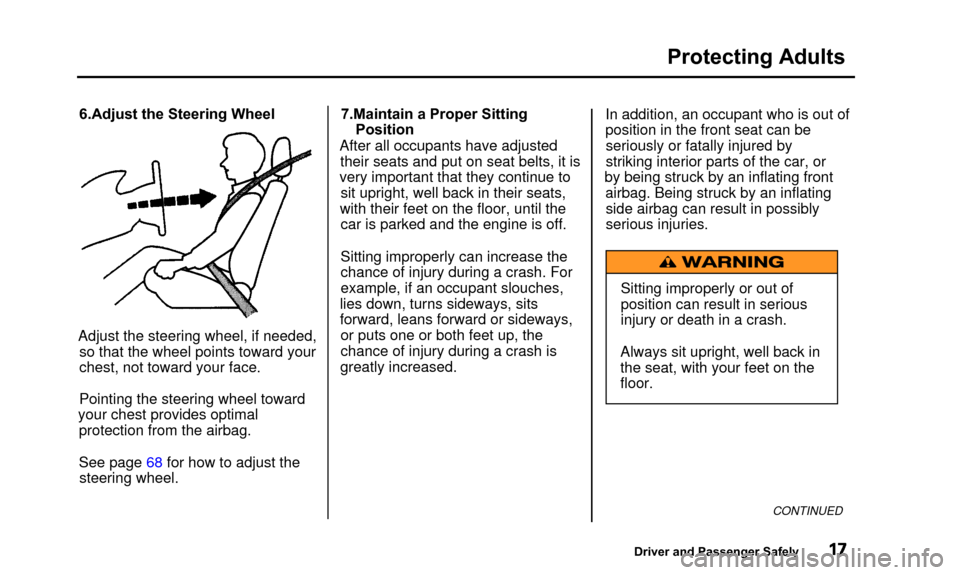
Protecting Adults
6.Adjust the Steering Wheel
Adjust the steering wheel, if needed, so that the wheel points toward your
chest, not toward your face.
Pointing the steering wheel toward
your chest provides optimal protection from the airbag.
See page 68 for how to adjust thesteering wheel. 7.Maintain a Proper Sitting
Position
After all occupants have adjusted their seats and put on seat belts, it is
very important that they continue to sit upright, well back in their seats,
with their feet on the floor, until the car is parked and the engine is off.
Sitting improperly can increase the
chance of injury during a crash. For
example, if an occupant slouches,
lies down, turns sideways, sits
forward, leans forward or sideways, or puts one or both feet up, the
chance of injury during a crash is
greatly increased. In addition, an occupant who is out of
position in the front seat can be
seriously or fatally injured by
striking interior parts of the car, or
by being struck by an inflating front airbag. Being struck by an inflatingside airbag can result in possibly
serious injuries.
Sitting improperly or out of
position can result in serious
injury or death in a crash.
Always sit upright, well back in
the seat, with your feet on the floor.
CONTINUED
Driver and Passenger Safely
Page 48 of 311
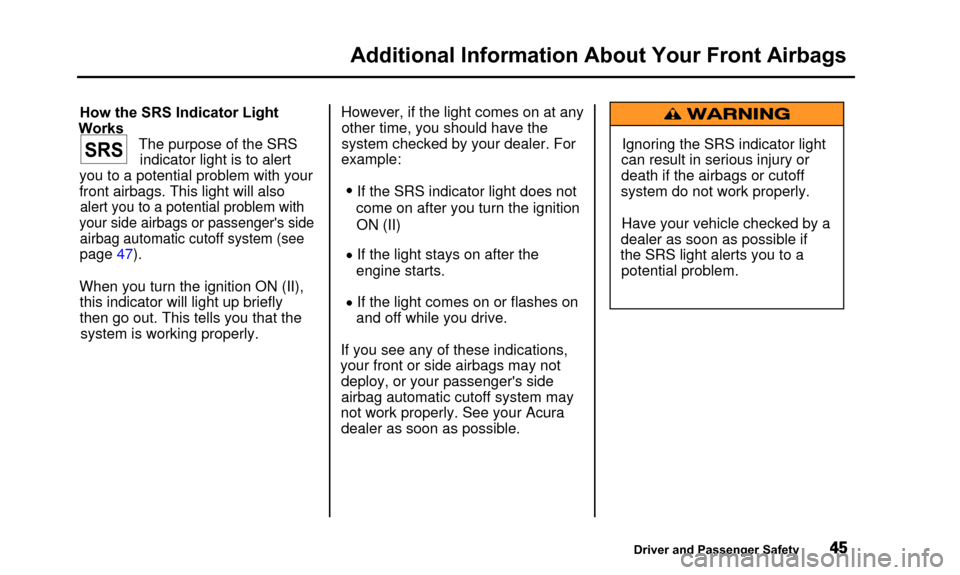
Additional Information About Your Front Airbags
How the SRS Indicator Light
Works The purpose of the SRSindicator light is to alert
you to a potential problem with your
front airbags. This light will also
alert you to a potential problem with
your side airbags or passenger's side airbag automatic cutoff system (see
page 47).
When you turn the ignition ON (II), this indicator will light up briefly
then go out. This tells you that the system is working properly. However, if the light comes on at any
other time, you should have the
system checked by your dealer. For
example:
• If the SRS indicator light does not
come on after you turn the ignitionON (II)
• If the light stays on after the engine starts.
• If the light comes on or flashes onand off while you drive.
If you see any of these indications,
your front or side airbags may not deploy, or your passenger's side
airbag automatic cutoff system may
not work properly. See your Acura dealer as soon as possible. Ignoring the SRS indicator light
can result in serious injury or
death if the airbags or cutoff
system do not work properly.
Have your vehicle checked by a
dealer as soon as possible if
the SRS light alerts you to a potential problem.
Driver and Passenger Safety
SRS
Page 52 of 311
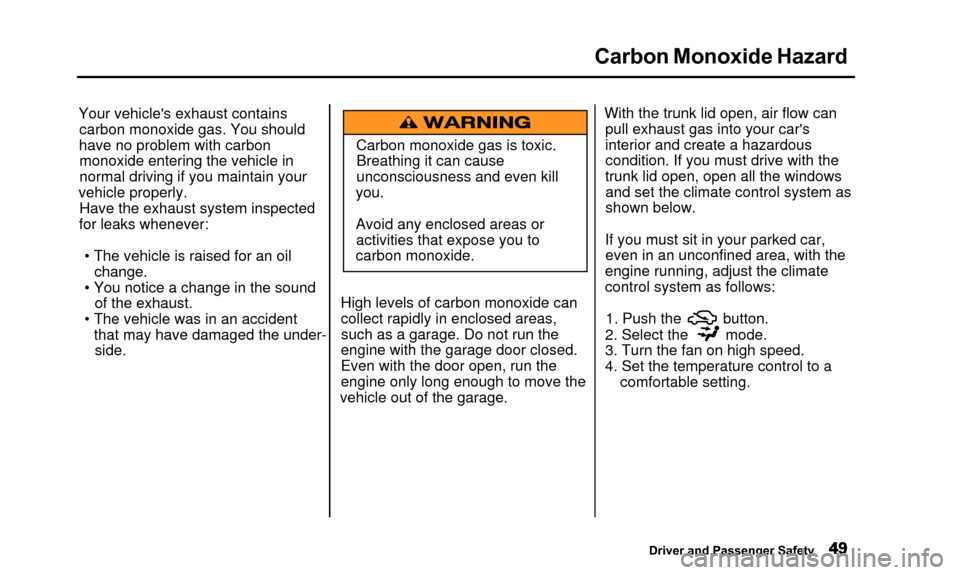
Carbon Monoxide Hazard
Your vehicle's exhaust containscarbon monoxide gas. You should
have no problem with carbon monoxide entering the vehicle in
normal driving if you maintain your
vehicle properly.
Have the exhaust system inspected
for leaks whenever:
• The vehicle is raised for an oil change.
• You notice a change in the sound of the exhaust.
• The vehicle was in an accident that may have damaged the under-side. Carbon monoxide gas is toxic.
Breathing it can cause
unconsciousness and even kill
you.
Avoid any enclosed areas or activities that expose you to
carbon monoxide.
High levels of carbon monoxide can
collect rapidly in enclosed areas, such as a garage. Do not run the
engine with the garage door closed.
Even with the door open, run the
engine only long enough to move the
vehicle out of the garage. With the trunk lid open, air flow can
pull exhaust gas into your car's
interior and create a hazardouscondition. If you must drive with the
trunk lid open, open all the windows and set the climate control system as
shown below.
If you must sit in your parked car, even in an unconfined area, with the
engine running, adjust the climate
control system as follows:
1. Push the button.
2. Select the mode.
3. Turn the fan on high speed.
4. Set the temperature control to a
comfortable setting.
Driver and Passenger Safety
Page 57 of 311
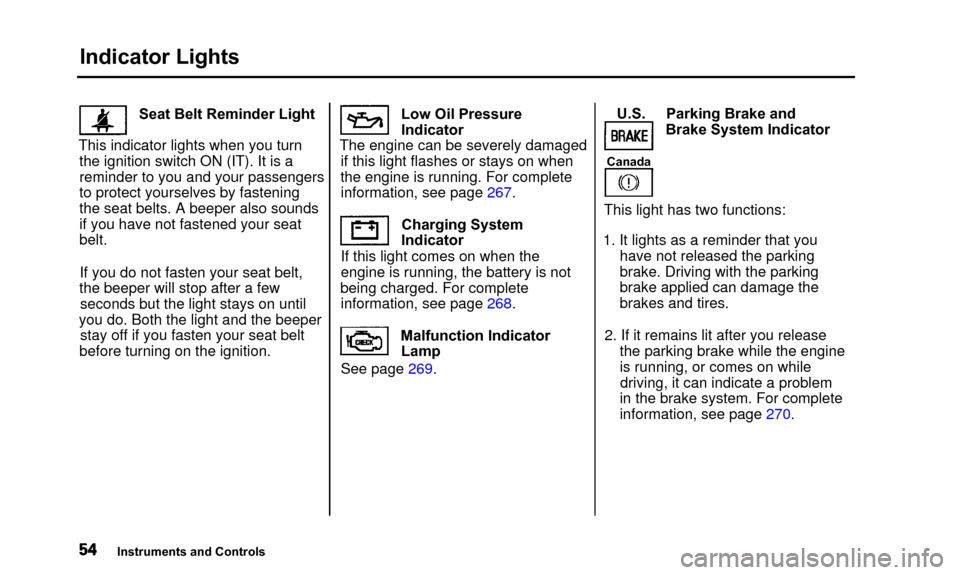
Indicator Lights
Seat Belt Reminder Light
This indicator lights when you turn the ignition switch ON (IT). It is a
reminder to you and your passengers
to protect yourselves by fasteningthe seat belts. A beeper also sounds
if you have not fastened your seat
belt.
If you do not fasten your seat belt,
the beeper will stop after a few seconds but the light stays on until
you do. Both the light and the beeper stay off if you fasten your seat belt
before turning on the ignition. Low Oil Pressure
Indicator
The engine can be severely damaged if this light flashes or stays on when
the engine is running. For complete information, see page 267.
Charging System
Indicator
If this light comes on when the
engine is running, the battery is not
being charged. For complete information, see page 268.
See page 269. Malfunction Indicator
Lamp U.S. Parking Brake and
Brake System Indicator
Canada
This light has two functions:
1. It lights as a reminder that you have not released the parking
brake. Driving with the parking
brake applied can damage the
brakes and tires.
2. If it remains lit after you release the parking brake while the engine
is running, or comes on whiledriving, it can indicate a problem
in the brake system. For complete
information, see page 270.
Instruments and Controls
Page 58 of 311
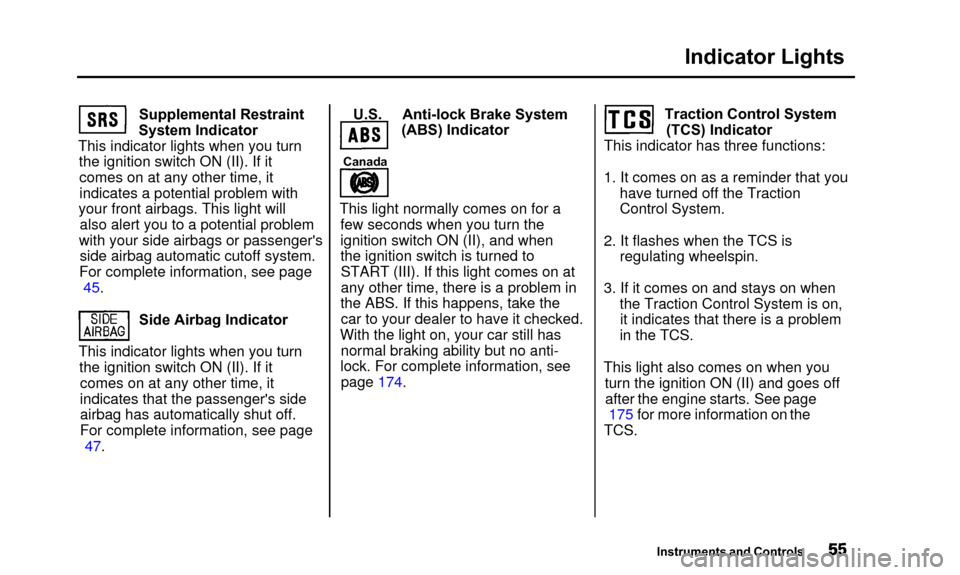
Indicator Lights
Supplemental Restraint
System Indicator
This indicator lights when you turn the ignition switch ON (II). If itcomes on at any other time, it
indicates a potential problem with
your front airbags. This light will also alert you to a potential problem
with your side airbags or passenger's side airbag automatic cutoff system.
For complete information, see page 45.
Side Airbag Indicator
This indicator lights when you turn the ignition switch ON (II). If itcomes on at any other time, it
indicates that the passenger's side
airbag has automatically shut off.
For complete information, see page 47. U.S. Anti-lock Brake System
(ABS) Indicator
Canada
This light normally comes on for a
few seconds when you turn the
ignition switch ON (II), and when
the ignition switch is turned toSTART (III). If this light comes on at
any other time, there is a problem in
the ABS. If this happens, take the car to your dealer to have it checked.
With the light on, your car still has normal braking ability but no anti-
lock. For complete information, see page 174. Traction Control System
(TCS) Indicator
This indicator has three functions:
1. It comes on as a reminder that you have turned off the TractionControl System.
2. It flashes when the TCS is regulating wheelspin.
3. If it comes on and stays on when the Traction Control System is on,it indicates that there is a problem
in the TCS.
This light also comes on when you turn the ignition ON (II) and goes offafter the engine starts. See page 175 for more information on the
TCS.
Instruments and Controls
Page 60 of 311
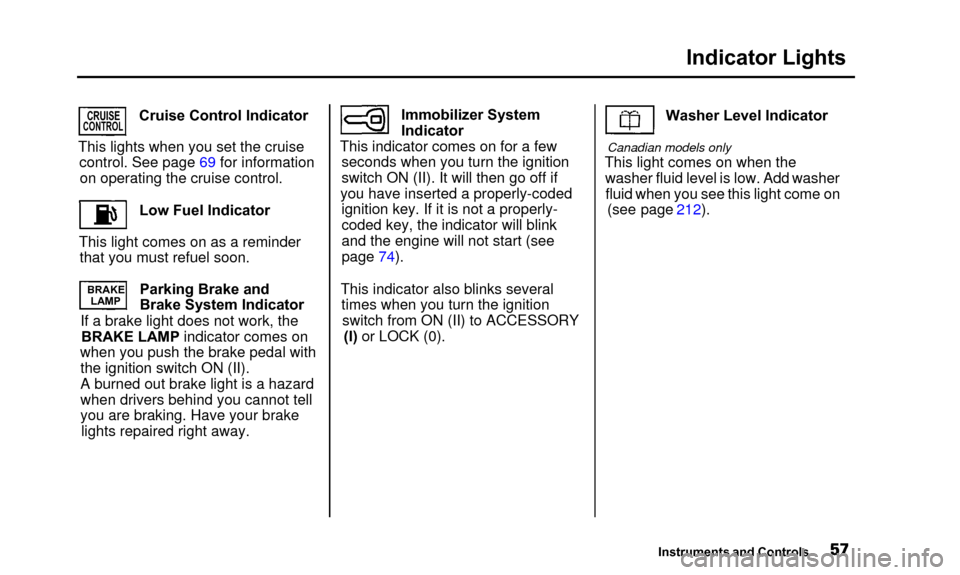
Indicator Lights
CRUISECONTROLCruise Control Indicator
This lights when you set the cruise control. See page 69 for informationon operating the cruise control.
Low Fuel Indicator
This light comes on as a reminder that you must refuel soon.
BRAKE LAMPParking Brake and
Brake System Indicator
If a brake light does not work, the BRAKE LAMP indicator comes on
when you push the brake pedal with the ignition switch ON (II).
A burned out brake light is a hazard
when drivers behind you cannot tell
you are braking. Have your brake lights repaired right away. Immobilizer System
Indicator
This indicator comes on for a few seconds when you turn the ignition
switch ON (II). It will then go off if
you have inserted a properly-coded ignition key. If it is not a properly-
coded key, the indicator will blink
and the engine will not start (see
page 74).
This indicator also blinks several times when you turn the ignition switch from ON (II) to ACCESSORY (I) or LOCK (0). Washer Level Indicator
Canadian models only
This light comes on when the
washer fluid level is low. Add washerfluid when you see this light come on (see page 212).
Instruments and Controls
Page 61 of 311
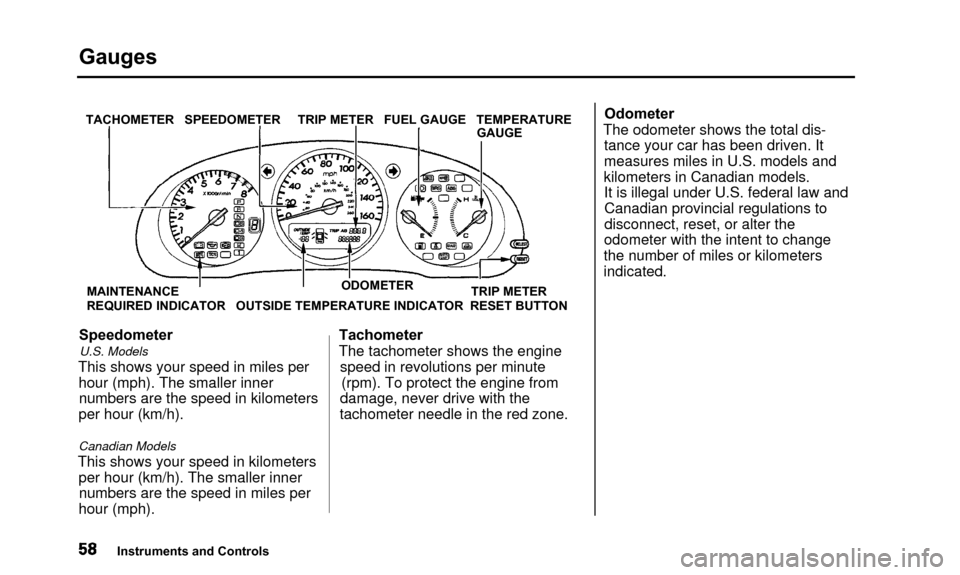
Gauges
TACHOMETER SPEEDOMETER TRIP METER FUEL GAUGE TEMPERATUREGAUGE
MAINTENANCE TRIP METER
REQUIRED INDICATOR OUTSIDE TEMPERATURE INDICATOR RESET BUTTON
Speedometer
U.S. Models
This shows your speed in miles per hour (mph). The smaller innernumbers are the speed in kilometers
per hour (km/h).
Canadian Models
This shows your speed in kilometers per hour (km/h). The smaller innernumbers are the speed in miles per
hour (mph). Tachometer
The tachometer shows the engine
speed in revolutions per minute (rpm). To protect the engine from
damage, never drive with the
tachometer needle in the red zone. Odometer
The odometer shows the total dis- tance your car has been driven. It
measures miles in U.S. models and
kilometers in Canadian models. It is illegal under U.S. federal law andCanadian provincial regulations to
disconnect, reset, or alter the
odometer with the intent to change
the number of miles or kilometers
indicated.
Instruments and Controls ODOMETER
Page 62 of 311
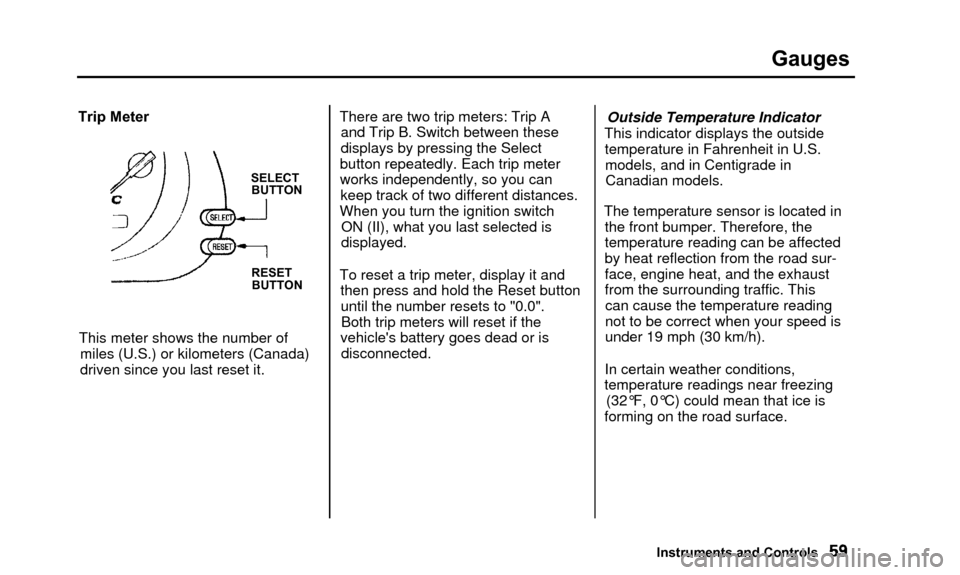
Gauges
Trip Meter
SELECTBUTTON
RESET
BUTTON
This meter shows the number of
miles (U.S.) or kilometers (Canada)
driven since you last reset it. There are two trip meters: Trip A
and Trip B. Switch between these
displays by pressing the Select
button repeatedly. Each trip meter
works independently, so you can keep track of two different distances.
When you turn the ignition switch ON (II), what you last selected is
displayed.
To reset a trip meter, display it and then press and hold the Reset buttonuntil the number resets to "0.0".Both trip meters will reset if the
vehicle's battery goes dead or is disconnected. Outside Temperature Indicator
This indicator displays the outside temperature in Fahrenheit in U.S.models, and in Centigrade inCanadian models.
The temperature sensor is located in the front bumper. Therefore, the
temperature reading can be affected
by heat reflection from the road sur-
face, engine heat, and the exhaustfrom the surrounding traffic. This can cause the temperature reading
not to be correct when your speed is
under 19 mph (30 km/h).
In certain weather conditions,
temperature readings near freezing (32°F, 0°C) could mean that ice is
forming on the road surface.
Instruments and Controls
Page 63 of 311
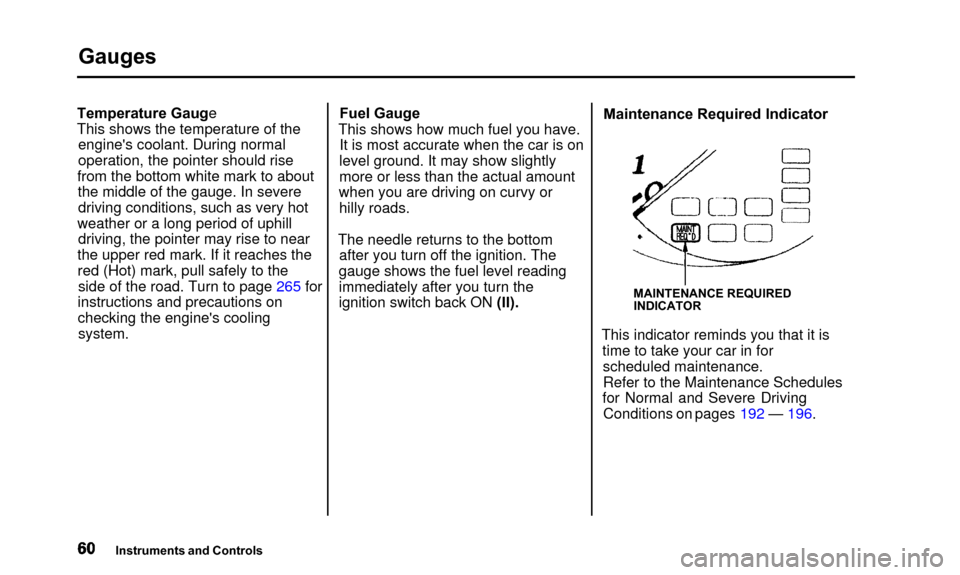
Gauges
Temperature Gauge
This shows the temperature of theengine's coolant. During normal
operation, the pointer should rise
from the bottom white mark to about the middle of the gauge. In severedriving conditions, such as very hot
weather or a long period of uphill driving, the pointer may rise to near
the upper red mark. If it reaches the red (Hot) mark, pull safely to theside of the road. Turn to page 265 for
instructions and precautions on
checking the engine's cooling system. Fuel Gauge
This shows how much fuel you have. It is most accurate when the car is on
level ground. It may show slightly
more or less than the actual amount
when you are driving on curvy or hilly roads.
The needle returns to the bottom after you turn off the ignition. The
gauge shows the fuel level reading
immediately after you turn the
ignition switch back ON (II). Maintenance Required Indicator
MAINTENANCE REQUIRED
INDICATOR
This indicator reminds you that it is
time to take your car in forscheduled maintenance.Refer to the Maintenance Schedules
for Normal and Severe Driving Conditions on pages 192 — 196.
Instruments and Controls